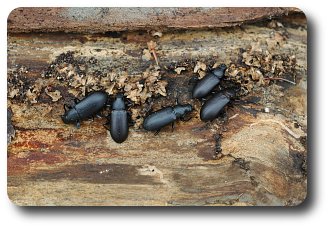Galleries like these beneath the bark of my firewood are often made by roundheaded borers.
With the return of winter weather, you may be replenishing your woodpile. As you split firewood take a few moments to peel back the loose bark on your logs. You might be surprised by what you find. If your firewood is not too old and rotten, just beneath the bark you may find serpentine galleries that wend their way along the space between the hard wood of the interior of the log and the bark.
Roundheaded borers have powerful jaws but usually lack legs.
Examine the bark you hold and you will see the mirror image of this trail. Galleries like these are often created by larvae called roundheaded borers. The galleries beneath the bark of my maple logs were chuck full of roundheaded borers. After completing development beneath the bark they chew a round hole to the outside and emerge as a longhorned beetle, so named for the remarkable length of their antennae.
The adult stage of a roundheaded borer is a longhorned beetle named for its very long antennae.
Many species of roundheaded borers like the ones tunneling through my maple logs prefer to eat the tissues of dying or dead trees. Some like the dreaded Asian Longhorned Beetle attack living trees. This beetle is responsible for the death of thousands of landscape trees in New York, Chicago, and New Jersey since its introduction in the 1990’s. Others like larvae of the magnificent milkweed longhorned beetle feed on the roots of herbaceous plants like milkweed. Roundheaded borers that eat wood have powerful jaws to chew their way through the hard plant tissues. Longhorned beetles can be found on flower heads where they eat nectar and pollen. They are also attracted to porch lights in the warm months of the year. If you bring fire wood into your home and store it for an extended time before you use it, you may be treated to the emergence of several wonderful longhorned beetles. As I peeled back the lose bark of a second log, I discovered a bevy of darkling beetles.
Although he is moving rather slow now, this darkling beetle larva will develop quickly when warmer temperatures return.
Darkling beetles often spend the winter in a frigid scrum in protected locations such as beneath the bark of trees awaiting the warmth of spring to resume their activities. Most darkling beetles feed on plant material of some sort – living or decaying. Some species of the darkling clan go by another common name, mealworms. Mealworms occasionally become pests of stored products such as grains and cereals in the pantry. They are also prized bait of fishermen. Not far from where the adult darkling beetles huddled, several darkling beetle larvae moved at a glacial pace through the decaying wood beneath the bark. Like their roomies, the roundheaded borers, darkling beetle larvae will complete their development when the warmth of spring returns. So, on a wintry night “while you are singing the songs you love to sing without a single stop at the fireplace while you watch the chestnuts pop, pop, pop”, listen carefully, there may be more than chestnuts popping.
References:
For more information on roundheaded borers and other borers in firewood and darkling beetles, please visit the following web sites.
http://www.ext.colostate.edu/PUBS/INSECT/05563.html
http://ohioline.osu.edu/hyg-fact/2000/2127.html
http://insected.arizona.edu/mealinfo.htm




